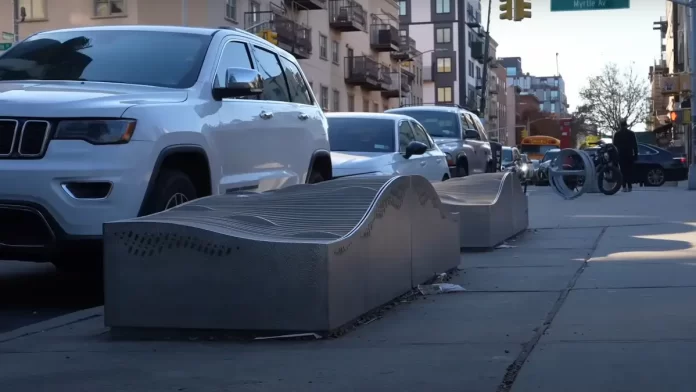New York City, a vibrant metropolis known for its diversity and cultural richness, harbors a darker side: its widespread use of “hostile architecture.”
This term refers to design elements incorporated into public spaces that deliberately discourage or prevent specific activities, often targeting the homeless population.
From installing armrests on benches to placing spikes on ledges, these seemingly innocuous design choices raise serious ethical and human rights concerns.
What is Hostile Architecture?
Hostile architecture, also known as defensive architecture or deterrent design, encompasses a range of architectural features designed to discourage specific behaviors in public spaces.
These features can be subtle, such as angled ledges or sloped benches, or more overt, like metal bars across doorways or sprinklers activated at night.
While the intended purpose is to maintain order and deter unwanted activities like loitering, sleeping, or skateboarding, the impact often falls disproportionately on marginalized groups, particularly the homeless.
History and Purpose
The origins of hostile architecture can be traced back to the 1960s, when it was first used in London to deter street gangs and vandalism.
In New York City, its use has become increasingly pervasive over the past few decades, particularly in areas frequented by tourists and wealthy residents. Proponents argue that it improves public safety, reduces crime, and maintains the aesthetic appeal of public spaces.
However, critics argue that these claims are often unfounded and that hostile architecture does little to address the root causes of homelessness and social problems.
Recent Developments
In recent years, there has been growing awareness and public outcry against hostile architecture in New York City.
Activist groups like “Hostile Design NYC” and “Design for Dignity” have been documenting and raising awareness about these design choices.
Their efforts have led to some positive changes, such as the removal of controversial “hostile benches” and the City Council passing a resolution in 2019 acknowledging the negative impacts of such designs.
Effectiveness
Despite the claims of its effectiveness, the actual impact of hostile architecture is questionable.
Studies have shown that it does little to deter unwanted activities and often simply displaces the homeless population to other areas.
Moreover, it can have detrimental effects on public health and safety, forcing people to sleep on the streets and in unsafe environments.
Concerns and Human Rights Issues
The use of hostile architecture raises serious concerns about social justice and human rights. Critics argue that it criminalizes poverty and homelessness, further marginalizing and stigmatizing vulnerable populations.
Additionally, it raises questions about accessibility and inclusivity in public spaces, creating barriers for people with disabilities or those simply seeking a place to rest.
Moving Forward
Moving forward, it is crucial for New York City to move away from hostile architecture and embrace inclusive design principles that prioritize people over profit and aesthetics. This can include:
- Investing in affordable housing and homeless services: Addressing the root causes of homelessness is essential for long-term solutions.
- Rethinking public spaces with inclusivity in mind: Designing public spaces that cater to the needs of all citizens,regardless of their socioeconomic status.
- Engaging in community dialogue: Including the perspectives of marginalized groups in the design process to ensure public spaces are truly welcoming and accessible.
- Enacting legislation: Implementing policies that restrict the use of hostile architecture and promote inclusive design practices.
Conclusion
Hostile architecture represents a dark chapter in the history of New York City’s public spaces. Its presence underscores the need for systemic change and a shift towards a more compassionate and inclusive approach to urban design.
By acknowledging the harmful impacts of hostile architecture and actively working towards dismantling it, New York City can take a step towards building a more equitable and just society for all.
